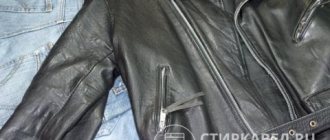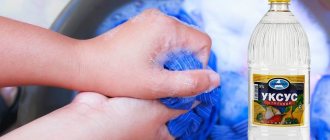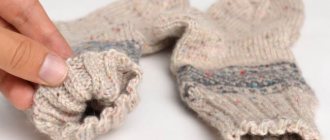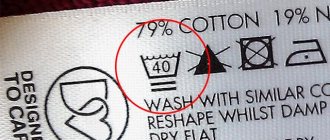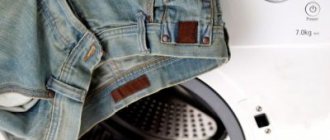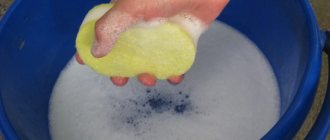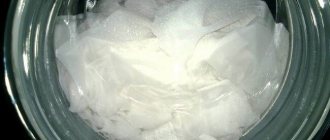When does the wool “shrink”?
A material such as wool, due to its naturalness and natural characteristics, can easily be modified under the influence of various sources. First of all, woolen items shrink when washed at high temperatures . Natural hairs curl, compact and “fall off”, which makes the product warmer, but significantly reduces its size.
Important! Items containing both real wool and artificial fibers can behave completely differently. Some things containing synthetics do not shrink at all, some only stretch. Therefore, for products with a mixed composition, methods typical for natural woolen items may not always be suitable.
How to wash acrylic in a washing machine
On the reverse side of the product you must find a label indicating the composition of the material, the washing and ironing temperature, as well as the possibility of using mechanical washing.
When machine washing, gentle modes are used:
- “delicate”, provides a temperature of no more than 30°C;
- “hand” means gentle washing;
- The “synthetic” program is provided for acrylic, “wool” is also suitable.
When choosing programs, you must ensure that the revolutions are in the range of 300-500 per minute, if turning off the spin is not possible and the water temperature does not heat up above 40°C.
Preliminary preparation includes:
- If there are stains, they must be removed before washing.
- If the product is heavily soiled, you can soak it in a cool soapy solution for 15-60 minutes.
- Turn out the pockets and remove all contents from them.
- Fasten the buttons and zippers, turn the item inside out.
- Acrylic products must be placed in a special mesh bag. This will protect them from stretching and friction while the centrifuge is running.
- Pour detergent intended for synthetics into the soap compartment.
- In the rinsing compartment - rinse aid or table vinegar - 9% (1/3 cup).
- Double rinsing is encouraged.
Despite the durability of the paint, white products lose their whiteness, become washed out and gray. This occurs when using products containing chlorine, frequent improper washing with other things, and increased hardness of tap water. If industrial products do not help, you can use a soda solution (5 tbsp) for whitening.
If the sweater manufacturer allows machine washing, then follow the instructions. Important points are the choice of mode, temperature indicators and the detergent used.
To wash sweaters, the drum should not be fully loaded. Recommended – no more than 2/3 of the volume.
Procedure:
- You need to make sure that there are no brooches or other removable decor on the item, and that the sweater itself does not need to be repaired.
- Turn the product inside out.
- Place the sweater in a laundry bag. If it is not available, put it in a pillowcase, which should be fastened or tied.
Pour a dose of detergent in gel form into the container. It is preferable to washing powder.- Place the sweater in the drum.
- Select the “delicate” or “manual” mode. For woolen clothing, "wool" can be used.
- Set the temperature to 30ºС, unless otherwise permitted by the manufacturer.
- Set the spin to minimum (if the material is dense and not loose) or turn it off completely (preferably for hand-knitted items).
- Start the wash cycle.
- After finishing the processing, you must immediately remove the item from the drum, wring it out and begin drying according to all the rules.
Items that do not have any special instructions on their labels are suitable for machine washing. Colored underwear is selected by color, white separately.
Preparing things:
- fasten all fasteners;
- check pockets and folds for debris and other items;
- turn inside out;
- remove all difficult stains in advance.
Before loading into the machine, acrylic items are soaked for 10 minutes in soapy water. The drum should not be heavily loaded. Things take up less than half the space. Synthetic fabrics need a lot of space to perform well. If possible, turn off the spin and dry functions.
To prevent acrylic fiber from losing its shape and softness, use special products for synthetics, as well as conditioners and tap water softeners. Hard water makes acrylic less rough and increases the chance of pilling.
Fabric softener
To prevent clothes made from acrylic fiber from shrinking, you need to maintain temperature conditions. If the water temperature is above 40 degrees, then there is a high probability of deformation of the fabric.
If the item could not be saved and it has shrunk, then you can try to return it to its original form. Examine it. In the case when the change in size does not occur evenly and the clothing looks like a disproportionate flap, nothing can be done. It can be thrown away or used for other purposes.
Wring out the water by wrapping the clothes in a towel. Do not twist, just squeeze and let the water drain. Place on a horizontal surface and stretch, securing in the desired position. In this form, the clothes should dry. A shrunken hat can be pulled over a jar or other suitable object.
If the conditioner procedure does not help, there is a more extreme option. Add turpentine and ammonia in small quantities to the water for soaking (no more than a tablespoon of turpentine, and no more than 3 alcohol for soaking one item). Attention! This method is not suitable for natural wool!
If the sweater or T-shirt has decreased in width, put the wet item on yourself and let it dry.
We invite you to familiarize yourself with the Air ionizer: benefits and harm to human health
The sweater shrank after washing
If clothes have stretched as a result of careless wear or strong spinning in a washing machine, then their appearance can be restored in the following way.
When this happened as a result of an incorrect spin mode, the stretching is usually uniform and along the entire length of the product. You can return it to its original size by washing the item in compliance with all the rules and using conditioner.
Optimal washing temperature
Basic information on proper care of items is on the label. At what temperature to wash so that large items lose a size or one and a half. If you set the machine to 60 degrees, carry out the full procedure and dry it with hot air, you can achieve success. If you wash wool in hot water, it will certainly shrink.
To make the product dry, you can choose a temperature twenty degrees higher than what the manufacturer suggests. A contrasting procedure comes to the aid of housewives.
If you wash wool in hot water and then rinse it in ice water, you will get the expected result. Such manipulations should not be permanent, as they affect the fibers of the fabric.
Washing wool clothes
Knitted items very often lose their original shape. But you can save the situation by using one of the proposed options.
1 way:
- The sweater or jacket must be immersed in water heated to 60 degrees, and after some time transferred to a bowl of cool water.
- After soaking, it is recommended to first squeeze the product lightly with your hands, pat dry additionally with a large towel, and then lay it out on a flat horizontal surface.
Method 2: You can also hang a sweater on the radiator in winter, after covering it with fabric. During the drying process, it is very important to give the product a compact shape.
If you want to reduce stretch in a woolen item, it is not advisable to machine wash it. The result may be the opposite of what was expected.
Method 3: Wool will shrink noticeably after regular washing with the addition of powder. The main thing is to wash it in hot water and then rinse it in cold water.
Knitted items must be dried exclusively in a horizontal position on natural fabric, giving them the desired shape. In winter, you can use a hot battery. To dry a woolen hat, it is advisable to choose an object that creates volume, for example, a liter jar.
You need to wash the wool so that it shrinks very carefully, because in pursuit of a new size there is a risk of getting miniature baby booties instead of adult socks. But if the wool product has shrunk more than you expected, you can return it to the required size by lowering it while still wet in cold water.
After 15 minutes, the soaked clothes should be carefully wrung out, placed on a terry towel and dried, periodically stretching them with your hands. If necessary, the absorbent fabric can be replaced several times with a dry one.
By the way, you can return things to the desired size after shrinking in other ways.
Woolen items can be stretched by following these instructions:
- Set the temperature 20 degrees higher than indicated on the label. As a rule, it is 30-40 degrees. Therefore, in order for the wool to shrink, you need to set the temperature to 50-60 degrees.
- Select the “Wool” mode, and if there is none, set the “Hand Wash” mode. The number of revolutions should not be more than 600.
- Fill your washing machine with baby laundry detergent.
- Place the clothes in the washing machine.
- After the machine has washed, take the item out and place it in a bowl of cold water with ice cubes added. Stir the item in this solution periodically for 10 minutes. Then rinse it at room temperature. This can be repeated 2-3 more times. This is done for the reason that the wool shrinks due to sudden temperature changes.
- After washing, gently wring out the item without twisting it. Wrap in a towel and squeeze out the remaining water again. Then place the item on a dry sheet or towel and straighten it carefully. Align your clothes according to size. You will see how the size of the thing has changed.
We suggest you familiarize yourself with How to get rid of dust in an apartment for a long time, where dust in an apartment comes from, how to deal with dust in an apartment
Do not dry woolen items on hangers or on a line. Under the weight of the water that remains on the surface of the item after washing, the product can stretch even more, and your result will be zero.
We also recommend that you study the article about the rules for washing woolen items.
Washing rules to make woolen items shrink
In order to “plant” a knitted item, you need to pay attention to several parameters. If you follow all of them, you will be able to carry out the procedure without incident, as a result of which you will have a sweater of the ideal size.
Temperature
First, pay attention to the label on your item, as the temperature at which it should be washed is always written above it. Since we are pursuing slightly different goals and want the product to change slightly, we should “conjure” with the temperature regime. Typically, the optimal temperature for washing wool is 30–40 °C , but we need to increase it by 20 °C to make clothes smaller.
Mode
The best option is to wash the item by hand . However, if you are lazy or simply don’t have enough time, use a washing machine. To do this, set it to one of the following modes:
- "wool". Its settings are usually set to a small number of revolutions. This is a good feature because at high speeds a wool sweater can change from adult to child size;
- “hand wash”, “children’s mode”. These programs are also quite delicate, so they are suitable for washing.
Hand knitted item
The problem with hand-knitted items is often that there may not be a tag on it indicating the specific material and the required washing temperature . If you are sure that the hat you bought from a craftswoman is truly completely natural, then you can try reducing its size by steaming. Do this through a cloth so as not to damage the delicate texture. If you do not have accurate information about the composition of the yarn, then it is better to wait with steaming. Try reducing it using the washing method.
Machine knitted item
An important feature of wool products is that they will retain the shape in which they dry . Therefore, if dried incorrectly, even machine knitting can suffer and stretch. This can be corrected by drying the sweater again. For this:
- wash the sweater or just soak it well in water. It must be completely saturated. If you are afraid that it will shrink very much in the water, then use a contrasting method: do not immediately soak the item in too hot water;
- After this, remove the clothing, but do not wring or twist it - this will damage the fibers again. It is better to place it on a flat surface (for example, in a bathtub, basin or on a special board) in a free position and allow excess water to drain;
- wrap it in a thick cloth or terry towel that will absorb unnecessary moisture. This method will replace traditional squeezing;
- change the fabric or towel, spread it on a flat surface, and place your sweater on top. Give it the desired shape, for example, lay a collar or adjust it in length. This is the form the product will be in when it dries.
Important! Wool takes a long time to dry; at room temperature it can dry for 2–3 days. Make sure that it does not acquire an unpleasant musty smell, so if necessary, change the towel on which it lies.
How to prevent things from stretching?
Delicate fabrics should be washed according to the manufacturer's recommendations. Do not increase the water temperature and the number of spin speeds. When washing by hand, it is recommended to avoid prolonged soaking, for several hours. It is better to remove difficult stains using special products designed for delicate fabrics.
When washing, you can add conditioner to the water. It will make the fabric soft and less susceptible to deformation. Additionally, it is recommended to use water that has passed through a purification filter.
In addition to spinning at high speeds in the washing machine, delicate items are afraid of twisting. Fabric stretching also occurs if items are dried vertically. For this reason, sweaters and cardigans should not be hung on trempels or secured to a clothesline with clothespins. In a closet, it is recommended to store such things on a shelf, especially if they are heavy.
To avoid having to make the sweater smaller, when wearing it, it is recommended to give up the habit of pulling the sleeves, trying to cover the hands with them. In this case, it is recommended to immediately purchase a product whose style implies a lowered (elongated sleeve).
You need to take off your sweater correctly. To prevent it from stretching, it is recommended to take the product by the bottom edge and, using the method of turning it inside out, lifting it up, remove it over the head at the same time as the sleeves.
Equipment and care products
- Equipment
- Facilities
Which washing machine to choose
How to iron with less effort and more comfort
How to quickly and easily iron anything
How to save time and quickly dry clothes and bedding
Review of classic, travel, wireless, smart and professional models
The best options in terms of quality, reliability and price
Rating of the best floor and ceiling models
The best dryers of ceiling, floor, wall types and models that can be installed on a bathtub or radiator
Choosing a product for adult and children's underwear
The best products for white, colored and children's underwear
Top 15 products for colored, white and children's underwear
Choose an antibacterial, biodegradable and hypoallergenic laundry detergent
Choosing the best laundry detergent
Choosing sheets for white, colored and children's linen
Top 15 best positions for washing adult and children's clothes
Rating of detergents for white and colored laundry
How to keep items made from natural fabrics clean and in shape
Choosing a product to quickly remove stains of any complexity
How to wash so that only the sleeves shrink?
If you are not satisfied with only the sleeves in a knitted product (for example, you pulled them unsuccessfully when putting on a sweater), then you can try to reduce only their length or width. For this:
- spray the sleeves with water from a special spray bottle or simply wet them carefully without touching other areas;
- lay the item horizontally again, straighten the sleeves and give them the required shape in length or width;
- wait for it to dry.
Advice! You can also try simply steaming only the sleeves. The main thing is that hot steam does not get on the main part of the blouse.
How to wash a knitted item so that it shrinks
Knitted items, especially hand-knitted ones, can stretch quite quickly and strongly. It is very difficult to bring them into their original form, since almost every yarn contains a synthetic additive. And the more acrylic, the stronger the thing stretches, but it does not always return to its size.
In addition, the pattern in which it is knitted affects the shrinkage of the item. Loose knits stretch more than tight machine knits.
Most often, machine washing is contraindicated for knitted items, but if shrinkage is necessary, follow these instructions:
- Buy a laundry bag. As a last resort, you can take an old tulle curtain and sew a pillowcase out of it, in which you will put the item. Don't forget to tie it. This is done to prevent your clothes from being scattered throughout the drum of the machine.
- Wash at a temperature no higher than 60 degrees. It is better to take liquid detergent or baby laundry detergent.
- Turn on spin mode. But here a single recipe cannot be given. Logically, stronger rotation will knock the yarn a little, and it will decrease in size. But in reality, the results can be completely unpredictable. Much depends on the twist of the yarn and the composition. Therefore, spin your item at medium speed, take it out, and look. If there are changes towards a decrease, but not strong, you can increase the speed of the machine and repeat the procedure. But all this is done under constant control.
If the item is very dear to you, it is better to try washing it by hand:
- Soak the item briefly in hot water with conditioner.
- After rinsing, transfer the item to ice water.
- Leave for 5-10 minutes and remove.
Twisting a knitted product is prohibited. It must be carefully squeezed out, and you can first wrap it in a terry towel.
It is necessary to dry a knitted item on a horizontal surface, since it can stretch when suspended. Drying takes place away from radiators and other heating devices.
Cotton
Practice shows that a cotton T-shirt stretches even faster than a wool sweater.
But even in this case, it is possible to adjust the shape of the thing. It is worth considering that when working with cotton, restoration is only possible if the clothing was sewn correctly. If the threads are located and directed incorrectly, then nothing can be done. Cotton products give maximum shrinkage in the following cases:
- Machine wash using very hot water and maximum spin.
- The product can simply be dipped in boiling water. True, even a short stay of a colored product in such hot water can provoke it to shed. But just five minutes of treatment will reduce the item by size, a quarter of an hour in boiling water and the clothes will become 1.5-2 sizes smaller.
- If you don’t want to risk the color of the item, then it is better to wash it in the traditional way, and then put it in an electric dryer.
We evaluate the result based on the completely dried product. If you can't do anything the first time, you shouldn't even try again. The positive effect most likely will no longer occur, but the item will ultimately be damaged. In this case, you will have to contact a studio or update your wardrobe.
If cotton clothing needs to be reduced in size, it should be machine washed in hot water. After adjusting the temperature on the washing machine, you need to set the temperature to more than 40 °C. If shrinkage by one or two sizes is required, the temperature should be set to the highest.
Cotton fabric stretches and contracts during the manufacturing process. When it heats up, the tension in the filament decreases, causing it to shorten. Heating can successfully shrink almost anything. You need to use the longest wash cycle. High temperature along with water and cycling will be very effective.
To significantly shrink the item, you can put it in boiling water and hold it there for 10-20 minutes. The duration of the procedure promotes greater shrinkage. After boiling, the product must be rinsed in cold water.
Compared to other fabrics, the problem of how to wash cotton so that it shrinks is not particularly difficult. T-shirts made from this material stretch even faster than a wool sweater. But there is always the opportunity to return the product to its original shape.
How to wash cotton so that it shrinks?
There are two ways to reduce shrinkage:
- First: a cotton jacket is placed in a washing machine, powder is added to the detergent container and a cycle is started with the temperature set to 60 degrees. Dry in a machine or on a clothesline, then iron and try on. This is the whole trick. Things will shrink after this procedure.
- Second: first you need to wash the cotton cardigan in the machine, then soak it in water (it should be boiling water) and wait until it cools down. After that, the item is transferred to a container with ice liquid, you can add ice cubes, squeeze it out and hang it on a clothesline to dry.
- Ironing will help shrink clothes. After washing and drying, the iron is turned on to maximum temperature and the supply of hot steam is activated. Just don’t keep the device in one place for a long time, as you could ruin your favorite blouse.
The result is assessed based on a completely dried and ironed product. If you didn’t succeed in reducing the item the first time, you shouldn’t try it a second time.
How to wash a thing so that it does not stretch and retains its shape?
Shrinking things sometimes does not give the desired results, and the clothes have to be thrown away. In order not to lose your favorite shirt, T-shirt or dress, you need to try to prevent their deformation. To do this, you must follow all recommendations for caring for products indicated on the labels: wash clothes in a way that does not destroy the structure of the fabric, use detergents that match the composition of the material, dry things properly.
Can it be washed and how often?
The manufacturer indicates the possibility of washing by hand or in a machine on the label on the item, which is sewn on the inside.
Depending on the resistance of the product to wet processing, the method of further cleaning is determined. Knitted items are demanding in terms of care and operating conditions.
Washing knitted items too frequently and unnecessarily can lead to pilling and a decrease in the service life of the product.
Careful wearing of the item, airing it, and proper storage will help prolong its use. You should not experiment with washing if the product label prohibits such processing.
How to iron woolen items
Usually, when drying properly, there is no need to iron. But if such a need arises, you must first of all find out the temperature of the iron indicated on the label. What to do in its absence is set out in the rules:
- Only completely dry items are ironed;
- the product is ironed from the inside out;
- To prevent shiny stripes from appearing, ironing should be done through moistened gauze or cotton cloth;
- The iron temperature setting indicator should be on the wool mark;
- To maintain its shape, you simply need to lower the iron onto the fabric without pulling it through.
We restore the heavily shrunken hem of the sweater by ironing it, after wetting this part.
How to dry acrylic items correctly
Proper drying of acrylic products is of no small importance for preserving the shape, size and color of clothing. To do this, any washed item is laid out horizontally on the grid surface of the clothes dryer or any other free horizontal surface. If it is a long scarf, you can fold it 2-4 times so that it fits in the designated space and does not hang vertically.
The tips given in the article are not complicated, but require mandatory adherence. Proper care of acrylic clothing will keep it in its original form and always look bright, stylish and impeccable.
Processing a sweater by hand is a gentle washing option that allows you to control the process at all stages.
For washing, it is necessary to prepare a large container, taking into account the fact that a wet item becomes bulky.
Instructions for this type of washing include the following steps:
- Inspect the product. If there are defects on it (for example, loose seams), they must be eliminated before washing.
Water at a temperature of 30ºC is poured into a large container (basin or bathtub).- Dilute the detergent in water until completely dissolved, following the instructions on the package.
- Dip the sweater into the water.
- Leave for no longer than 10 minutes.
- Wrinkle the item slightly, paying attention to the collar and cuffs.
- The water is drained, and the pullover itself is slightly wrung out.
- Rinse the item in clean water, changing it several times.
You can add fabric softener to the water during the last rinse to increase its softness.
Nitron should be washed at a temperature not exceeding 30 degrees. Powder and gel for synthetic fabrics and light laundry soap are used as detergents. First, water is taken into a container, then a synthetic agent is dissolved in it and the item is soaked in it. One item is soaked in one basin.
Lightly soiled items are left in soapy water for about 10 minutes. To remove difficult stains, clothes are soaked for a long time (from 1 to 2 hours, depending on the complexity).
Acrylic fabrics do not tolerate physical impact, therefore, to wash them, do not use brushes or boards. They should not be rubbed, lifted above water, stretched or twisted. To wring out acrylic clothing, squeeze it in your hands and place it on a towel or shallow rack.
Washing an acrylic sweater
Synthetics
Synthetic materials include nylon, polyester, acrylic. Typically, products made from such fabric are dry cleaned. The staff at this establishment will do their best to make clothing sizes slightly smaller.
But if you don’t have the time or money to take the product to a workshop or dry cleaner, try planting it yourself using simple methods.
How to wash things so that they shrink?
Correct methods for reducing synthetic products by 1–1.5 sizes:
- Soak the clothes in ice water for about 5 hours. Just be sure to wash and dry as usual before doing this. After soaking in ice water, the pants or jacket are blotted with a towel to remove excess moisture. Lay it out on a flat horizontal surface and try it on after drying.
- In the warm season, synthetic items are dried outside in direct sunlight. And in winter - on the battery.
Spandex, acrylic and polyester are not made smaller at home. But how can you make the product shrink a little?
Items made from such fabrics are sent to an atelier, where experienced craftswomen work on them and alter them to the required size. At home, they will not shrink, but will only deteriorate if the temperature is set incorrectly.
Reducing individual elements
If the elastic band on a sweater has stretched, i.e. not the entire product, but its separate part (sleeves, neckline), then it can be restored separately without subjecting the entire fabric to water procedures. The jacket should be laid out on a flat horizontal surface. Use a spray bottle to moisten problem areas. When the fabric gets wet, it should be pulled so that the threads move in the opposite direction from the stretch. You can secure this position with a pin or rubber band. The sweater is left in this position until completely dry.
If the cuffs or other parts of the product have not stretched much, after moving the threads to the center, you can speed up the process of removing excess moisture. You can dry the sweater using an iron. To avoid damaging the fabric, it is recommended to iron the product through a piece of gauze folded several times. You can use a terry towel, but with each new ironing you should cover the jacket with the dry side.
Another method that cannot always be used to make a sweater smaller; in most cases, it is suitable for those products that were independently knitted. You can unravel the stretched part and then bandage it. To avoid having to unravel the entire sleeve if only the cuff is stretched, it is recommended to give preference to a needlework style that involves knitting from the elbow to the hand. There are fewer problems with the neck. In most cases, it is knitted separately from the body of the sweater and then sewn on.
How to wash knitted clothes
Any woolen item can be planted very easily, since such material tends to “shrink” very well. When reducing, for example, an adult knitted hat, you should exercise maximum caution, because... it can turn into a nursery. You can start working only after normal washing and drying, since the material must be clean. After this you can start:
- Soak the hat in water, the temperature of which exceeds the temperature indicated in the recommendations on the label by 15°C. Wait 1 hour.
- Wash it lightly with soapy water, then rinse in cold water.
- Squeeze gently without twisting and place on a dry cloth for 30 minutes.
- Move to any surface where the hat will be ventilated and dry.
Additional method for washing knitted items - video:
An additional method that is suitable for quickly achieving the goal is this: wet the item with cold water, place it on a hot radiator, separating them with a dry cloth. It is not as effective as the main one, but it also has its place.
We wash polyester and other synthetics
It is enough to wash polyester and nylon with your hands in cold water, and the clothes will immediately “shrink” a little. When washing in a machine for the same purpose, you need to turn on the temperature mode indicated on the label, and then spin at medium speed.
Synthetic items shrink well if washed in water whose temperature is 10 degrees higher than that indicated on the manufacturer’s label.
Clothes made of nylon and polyester will shrink noticeably if they are dried in the sun in summer and on a radiator in winter.
Acrylic products will shrink in size if they are washed in a machine on a delicate cycle or at 30 degrees with minimal spin. Moreover, it is better to put all things in the drum in a special bag. Slightly damp clothes should be spread out on a clean cloth and left in this position until they are completely dry.
The achieved result will not last long; the next time you wash, all manipulations should be repeated. And to avoid stretching the fabric, such items should be stored folded on a shelf.
But if you have spacious clothes made of spandex or lycra, it is almost impossible to save the situation. The size of such products will not change, even if you use radical methods of washing, ironing and drying. Only the skillful hands of a seamstress can help.
Old items that have lost their original size should not be immediately removed from the closet. Some of them can still be returned to their desired shape if you use fairly simple recommendations. The main thing is to take into account the quality of the material and select the required temperature regime.
Remember that lycra with acrylic and spandex, polyester are not made smaller. If you need to significantly reduce your shirt, go to a tailor or buy other things. For example, a atelier can make a shorter spandex blouse. Entrust this to specialists, because you can ruin synthetics yourself.




